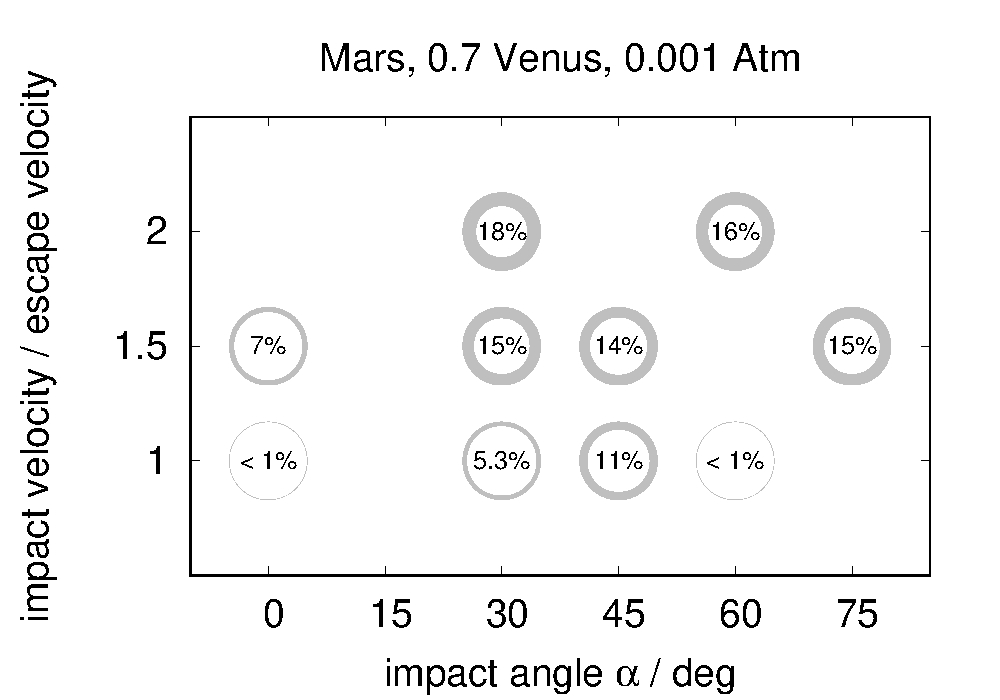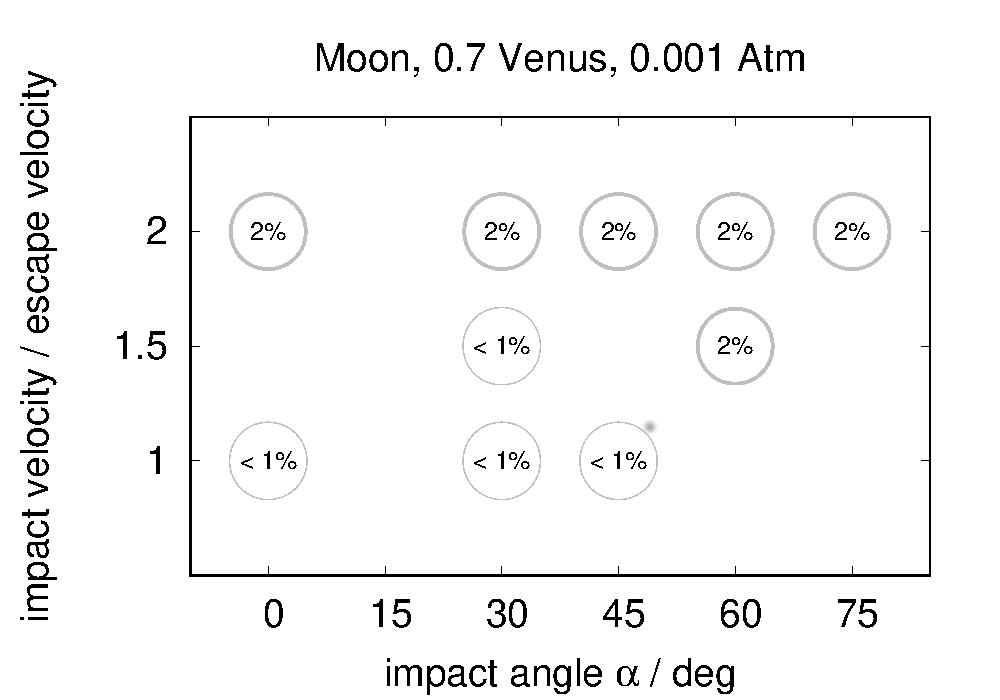Evolution of early Earth and Venus after impact events
- 1University of Vienna, Institute of Astrophysics, Vienna, Austria
- 2Space Research Institute, Austrian Academy of Sciences, Graz, Austria
- 3SDB Science-driven Business Ltd, Larnaca, Cyprus
- 4Institute of Astronomy and Astrophysics, University of Tübingen, Germany
Abstract
During the early stages of terrestrial planet formation collisions with other bodies were no scarcity. As this collisions shape the young planets by adding mass, removing mass, influencing the primordial atmosphere, etc. we take a closer look on such collisions. In the following abstract we concentrate on the loss of mantle material during giant impacts performed with fully 3D SPH simulations. As our simulations show, giant impacts can alter the ratio of silicates to iron (Si/Fe) at a protoplanet by losing more mantle than core material.
Introduction
The terrestrial planets, especially Earth and Venus, have formed over several million years by accreting planetesimals and planetary embryos. During these collisions various processes happened influencing not only the mass of the early planets but also the bulk composition and atmosphere [2]. Collisional erosion [3] is one of the processes that was suggested to fractionate lithophile from siderophile elements (i.e, elements that accumulate in the mantle vs iron-loving elements that accumulate in the core of a planet), and incompatible elements that tend to be incorporated into the crust from compatible elements that mainly stay in the mantle. This process might, therefore, be one of the reasons for Earth’s low Fe/Su and Fe/Mg ratios [1]. Furthermore, collisional erosion could also significantly alter the amount of heat producing elements within a terrestrial planet since U and Th are both highly incompatible and, thus, mostly residing within the crust [3]. This could have an important impact on planetary habitability, since variations in the initial heat budget might lead to completely different tectonic modes [4]; a decisive factor for the establishment of working carbon-silicate and nitrogen cycles.
Setup and Method
To investigate the loss of mantle material (i.e., magma ocean material) we performed 3D Smooth Praticle Hydrodynamics (SPH) simulations of protoplanets hit by Moon- and Mars sized embryos. The setup uses a target body with 0.6 MEarth which is hit by a projectile body of Moon- or Mars-mass. The bodies each consist of an iron core (30% of its mass) and a silicate mantle. A full range of possible impact angles from grazing to central is simulated along with different impact velocities (1-2 vesc , where vesc is the two-body escape velocity). The simulations were carried out with our miluphCUDA SPH code which includes self gravity and is run on GPUs [5].
Results


Figure 1: The plots show the mantle mass lost given in percent (grey area not
to scale). The effects of Moon-mass and Mars-sized impactors as a function
of impact angle (deg) and impact velocity (in units of vesc ) is shown.
Figure 1 shows the outcome of a collision with a Mars- respectively Moon sized embryo (top resp. bottom panel). It shows the mantle material lost during the impact event, given in percent of pre-collision mass. We assume the mantle material lost is constituted by all fragments containing silicate material that move at a velocity larger than the escape velocity relative to the biggest fragment (the surviving body). For a Mars sized impactor hitting the target body with 2.0 vesc and impact angle of 30°: 18% of mantle material is lost . This gives the highest loss-rate of mantle material observed in the simulations. An impact with 2.0 vesc and impact angle 60° leads to 16% material loss. Approximately the same rate of material loss is observed for the scenarios with 1.5 vesc at higher impact angles. For an impact angle of 0° at 1.5 vesc only 7% of mantle material is lost. With decreasing impact velocity the total loss of mantle material decreases, too. The highest loss for an impact velocity of 1.0 vesc is found for an impact angle of 45° ( = 11%). For 1.0 vesc at 0° and 60° less than 1% solid material is lost. A Moon sized impactor causes less total loss of mantle material. For 2.0 vesc at all angles approximately 2% of solid material are lost. The same amount is observed for an impact velocity of 1.5 vesc at 60°. All other scenarios show a mantle material loss of less than 1%.
Summary and Conclusions
In agreement with previous studies (e.g., [1]), our SPH-simulations show that highly energetic giant impacts can at least partially account for the fractionation between mantle and core material of a planet. It might, therefore, also have contributed to the elevated Fe/Si ratio of the present-day Earth. As a next step, we will also track the loss of U and Th within the primordial crust that is stripped by giant impacts, and study how such alteration of heat producing elements might affect the habitability of a terrestrial planet.
Acknowledgements
This research was funded in part by the Austrian Science Fund (FWF) [P33351-N].
References
[1] Carter, P.J., Leinhardt, Z.M:, Elliott, T., Walter, M., Stewart, S.T.: Compositional evolution during rocky protoplanet accretion; Astrophys. J., 813, 17, 2015.
[2] Lammer, H., Leitzinger, M., Scherf, M., et al.: Constraining the early evolution of Venus and Earth through atmospheric Ar, Ne isotope and bulk K/U ratios; Icarus, 339, 113551, 2020.
[3] O’Neill, H.S.C., Palme, H.: Collisional erosion and the non-chondritic composition of the terrestrial planets; Phil. Trans. Royal Soc. A, 366, 4205,2008.
[4] O’Neill, C, O’Neill, H.S.C., Jellinek, A.M.: On the Distribution and Variation of Radioactive Heat Producing Elements Within Meteorites, the Earth, and Planets; Space Sci. Rev., 216, id.37, 2020.
[5] Schaefer, C., Riecker, S., Maindl, T.I., Speith, R., Scherrer, S., Kley, W.: A smooth particle hydrodynamics code to model collisions between solid, self-gravitating objects; Astron. Astrophys. 590, A19, 2016.
How to cite: Loibnegger, B., Scherf, M., Maindl, T. I., Lammer, H., Pilat-Lohinger, E., Schäfer, C. M., Burger, C., and Zimmermann, M.: Evolution of early Earth and Venus after impact events, Europlanet Science Congress 2022, Granada, Spain, 18–23 Sep 2022, EPSC2022-712, https://doi.org/10.5194/epsc2022-712, 2022.

